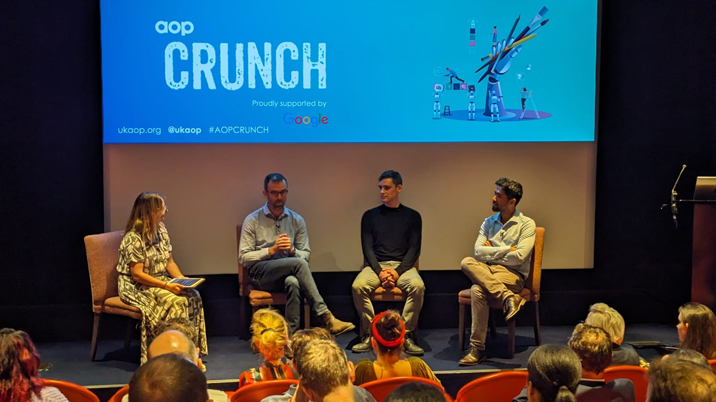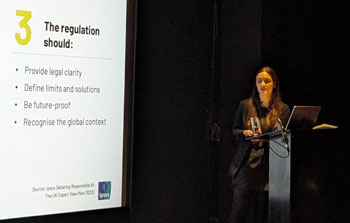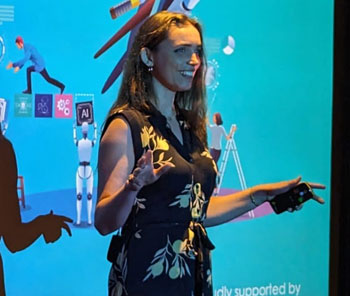
Since the release of ChatGPT, AI has been inescapable. Whether it’s at work, home or in the media, the confluence of machine learning, large language models, and generative AI has introduced both startling efficiency and baffling errors to our day-to-day lives. Digital publishers stand at the coalface of this technological revolution and will be among the first industries to realise its risks and rewards.
As we crest the peak of the hype cycle and begin to make sense of what AI can and can’t do – not to mention what it should and shouldn’t do – we heard from leading digital publishers and AI experts at the latest AOP CRUNCH about how the industry can develop new strategies and policies to adapt to this transformative new technology.
The public is torn on the pros and cons of AI

Ana Klafke, associate director at Ipsos, set the scene for the day’s discussion with the company’s latest findings on the UK public’s sentiments towards AI. She revealed that 9% of the online population used OpenAI’s ChatGPT in February 2024, peaking at 25% among 15-24 year-olds, with the highest growth seen in the 35-44 age group. Two in three people in the UK feel they have a good understanding of AI, but the same proportion are nervous about products and services that use the technology.
Perceived benefits of AI include doing tasks that people struggle with and improving entertainment. People broadly feel comfortable with AI being used for assistive functions, such as optimising traffic flow on roads and tailoring education and training programmes. Where the public is not comfortable is with AI giving advice or making decisions on someone’s behalf, or directing political content and advertising – as revealed in the Public Attitudes to AI report from Ipsos.
“Gen AI is like an exoskeleton,” said Klafke, quoting Michel Guidi, Ipsos’ COO. “It can help a body to run faster, jump higher, or carry more weight, but it still needs a human inside.”
Ethics are a vital tool for avoiding AI’s worst-case scenario

Like all risk assessments, judging the potential of AI means balancing the best and worst-case scenarios and the likelihood of each. Olivia Gambelin, author of Responsible AI and founder of Ethical Intelligence, took to the stage to present ethics as a tool to help publishers steer towards the best-case implementation of AI by aligning their values with their actions. Rather than impede technological progress, Gambelin has found that embedding ethics into decision-making gives people the confidence to act.
“I’ve watched team after team become frozen in place when they don’t have the guardrails in place; when they’re stuck thinking, ‘I can use this tool like this, but should I? Am I doing the right thing?’ You can lock teams down into this sense of fear if you’re not giving them those guidelines to help them move forward efficiently. Oftentimes with ethics, people think, ‘Oh, it’s a blocker.’ When, really, it unlocks the ability for teams to move forward with confidence because they know the parameters they’re operating within.”
Ethics overlaps with the ever-present question of diversity in AI development. Angie French, AI advisory and ethical intelligence architect at ALF Consulting, stressed the need for diversity of thought and experience in AI development from its inception to ensure the technology can benefit everyone in society, rather than entrench existing inequity and structural bias.
“We have an absolute catalogue of disasters behind us from an AI perspective of organisations that didn’t have the right people in the room at the start and ended up with unintended outcomes at the end,” said French. “When it comes to who is particularly frightened and nervous about AI, it’s marginalised groups that feel most afraid. And quite rightly, because those are the groups that have been the victim of some of the unintended outcomes of AI implementation in the past. They have every right to feel apprehensive because they’re probably not in the room during development; not party to the way that we’re designing the world moving forward.”
How publishers can prepare for a post-search internet
For digital publishers, the integration of AI into search is looking like a cause for concern. David Buttle, an independent consultant who, until recently, was director of platform strategy and public affairs for the Financial Times, discussed how the cannibalisation of search traffic by AI threatens publishers’ business models.
Buttle outlined three mechanisms through which publisher revenues might be impacted: AI-summarised search results in fewer clicks to publishers’ sites, with potential traffic loss varying from 20% to 70% depending on the search term; users might prefer AI chatbots for certain queries that once led to publisher sites; and, further afield, AI assistants could offer highly personalised news based on individual preferences, further reducing direct traffic to publishers.
So how can publishers adapt to the looming spectre of a post-search internet?
“Firstly, and most obviously, reduce your reliance on Google,” said Buttle. “Build direct relationships with your readers, build communities, expand your newsletters, grow your database; do everything you can to reduce your reliance on Google as a source of traffic. Secondly, be known for creating content that matters. For some search queries, the source of the information being sought is of real consequence. If you’re choosing a car or getting interview advice, then AI is going to have lower utility because we just don’t trust it. You’re going to turn to trusted brands instead, right? If your publication is trusted to provide content … which is of greater consequence to the end user, then you’ll be afforded some protection from this over the mid-term.
“Finally: distinctiveness. The usefulness of chatbots to answer queries about current events depends on their access to real-time information and synthesising multiple sources of information to present to the user. If you’re not producing commoditised information and you’re producing something distinctive and niche, then, again, you’re likely to be afforded some protection. If you’re known and trusted and have direct relationships built around that, or if you’re providing the commentary which is driving discourse, then even better. Giles Coren’s column in The Times is never going to be supplanted by people asking an AI what's happening in their day.”
Immediate’s inclusive approach to developing normalised AI acceptance

Hannah Williams, MD of digital content, and Katja Eggert, head of strategic development, work in Immediate’s content strategy and business development team – or, as Williams jokingly referred to it, the “what fresh hell is this?” department – where they support digital literacy and keep journalists abreast of ever-changing platform requirements.
At the end of 2022, when it became apparent that Generative AI would have enormous consequences for Immediate and the wider industry, Williams and Eggert drew up a “map” of all the areas of the business that would be affected, and realised its impact would be felt everywhere. Successfully integrating AI into Immediate would mean involving all teams and departments, spearheaded by internal AI “champions” who had existing enthusiasm and experience with the technology.
After splitting its Generative AI strategy into four pillars – audiences and ecosystem; learning and transformation; workflow productivity; and product innovation – Immediate ran an AI Immersion Day in July 2023 to level the understanding of the technology across the business with a series of talks and workshops led by technical experts. At the end, the entire company was asked to submit ideas for AI projects, with 71 projects submitted.
Building on this momentum, the entire company gathered in September for a two-day hackathon to develop AI projects in interdepartmental teams. This resulted in 27 workable proofs of concepts, including AI-generated children’s audiobooks, an AI proofreading tool, and a crossword generator. Nine of these projects are still ongoing, and a staff survey found that 70% of the company now feel confident about using AI tools.
“If you are sceptical [about AI], now’s not the time to lean back and turn away,” said Williams. “Now’s the time to get informed and get engaged so you’ve got some agency in shaping it.”
Four breeds of AI assistant lending a helping hand to digital publishers
AI solutions company, Bridged Media, has conducted more than 400 experiments with media organisations across the globe to identify ROI-positive use cases for AI.
Maanas Mediratta, the company’s CEO, shared which of these experiments yielded the best results: “We realised that creating content [with AI] is not the right way to go, and I think everyone would agree with that. What we found is that there are four kinds of [AI] assistants that you can develop within any content organisation. The first is a content assistant, which can help your editors do things faster, such as redaction tools, research tools, and SEO tools … The second are on-page assistants, which can help your visitors have a better experience by creating content in the format they like, personalising to them, creating quizzes, polls, or games … which helps increase on-page engagement.
“The third – which we found very ROI-positive – are monetisation assistants, which can help understand when to place an ad, what kind of format it should be, what should be a subscription strategy. The last one, my favourite, are data assistants. These help any media organisation understand what is happening in natural language. We have use cases we have developed where a team wants to know what kind of content worked this week? What topic, what tone of voice, what length? These data systems can break down what happened in the session to give insights in natural language.”
Newsquest and Bauer hope AI will let journalists get back to their roots
Jody Doherty-Cove is head of editorial AI at Newsquest, which has a portfolio of more than 250 local news brands producing online and print content. Newsquest’s first major implementation of AI was an internal copywriting tool that uses trusted information gathered by journalists to generate first drafts in house style. These drafts are then polished by human editors before publication, streamlining content production.
Now, Doherty-Cove leads a team of 14 AI-assisted journalists who were hired specifically to use Newsquest’s internal AI tools for content production and to support journalists across its many properties. Learnings from this team are then applied to the wider company, where over 3,500 AI-assisted articles are produced each month.
“We introduced this AI-assisted service on a trial basis – testing it out in different regions in turn,” said Doherty Cove. “After removing it from one region to trial in another, I got a very angry email from that newsroom, saying, ‘How dare you remove this! It’s been the best couple of weeks I’ve ever had. I’ve managed to get out, I’ve managed to go down to the street and do in-person interviews. And now I’m going to be stuck at the desk again, putting together the paper each week.’
“That really cuts to the heart of what [AI] can offer us. We can say to journalists, ‘Get back out, get contacts, get exclusive content’; the reasons why people got into journalism. For me, that’s what’s most exciting about it, it’s giving back time to the newsroom and we can spend that time to go and do a better job of journalism.”
Tim Pollard, digital editorial director at Bauer Media, has also recognised AI’s primary benefit as liberating journalists from the doldrums of digital publishing so that they can focus on their core newsgathering capabilities and creative passions. Pollard is capitalising on Bauer Media’s unification of all its properties under a single CMS to integrate AI both deeply and broadly across its many global brands, supported by peer-to-peer best practice and learning programmes.
For Pollard, technology turning media on its head is nothing new: “I’ve been in digital publishing for about 15 years. The journey we’ve been on from keyword stuffing back in the day! You’re so used to course adjusting – or U-turns, as some of the team call it – but we’re constantly having to change how we work and anyone in digital will be very familiar with that. For me, this is just more of that, but on a greater scale and changing so, so quickly.
“But at the core of it is human insight, the reason I went into journalism in the first place. AI is an enabler, because we’re having to spend less time doing metadata tagging and keyword research … so we’re spending our time making better content with better results.”










